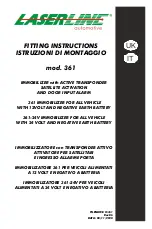
7
With a room height of more than 12 m, it is recommended to install a second
monitoring level on which the detectors are arranged offset to the first monitoring
level.
It is allowed to operate the detector through a glazed window or laminated
glass, with the angle between the normal to the base and the normal to the glass
should be more than 10 degrees.
The transmitter and the receiver are usually installed at the same height and
aligned with one another. The wide angle of view of the transmitter and receiver
allows for an easy installation and for a reliable long-term stability.
The detector must be mounted in a position where the receiver input window
is not exposed to direct sunlight or artificial light. Normal ambient light does not
affect the operation of the receiver.
3
OPERATION OF DETECTOR
3.1 Operation of transmitter IL
The transmitter operates continuously after power is applied and the
readiness time is complete. After the power is applied to confirm and verify the LED
itself, the transmitter gives one flash with duration of 1 second. The transmitter is
monitored by a green LED on its side, which should flash for a short time (0.25 s)
every 5 seconds.
3.2 Operation of receiver PL
The receiver operates continuously after power is applied and the readiness
time is complete. After the power is applied to confirm and verify the LED itself, the
receiver gives one flash with duration of 1 second.
The receiver outputs a signal "ALARM (FIRE)" by increasing the current
consumption and the "ALARM" output of the receiver is intended for the
transmission of an alarm signal by closing the contacts of the built-in relay (dry
contact; in the quiescent mode, the contacts are open).
The "FAULT" output of the receiver is intended for the transmission of a fault
signal by opening the contacts of the built-in relay (dry contact; in the quiescent
mode, the contacts are closed).
The states and indications of the transmitter IL and receiver PL are given in
Table 1.






































